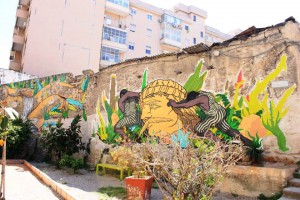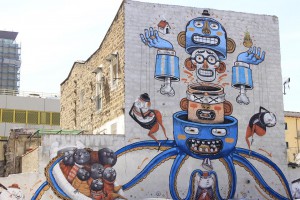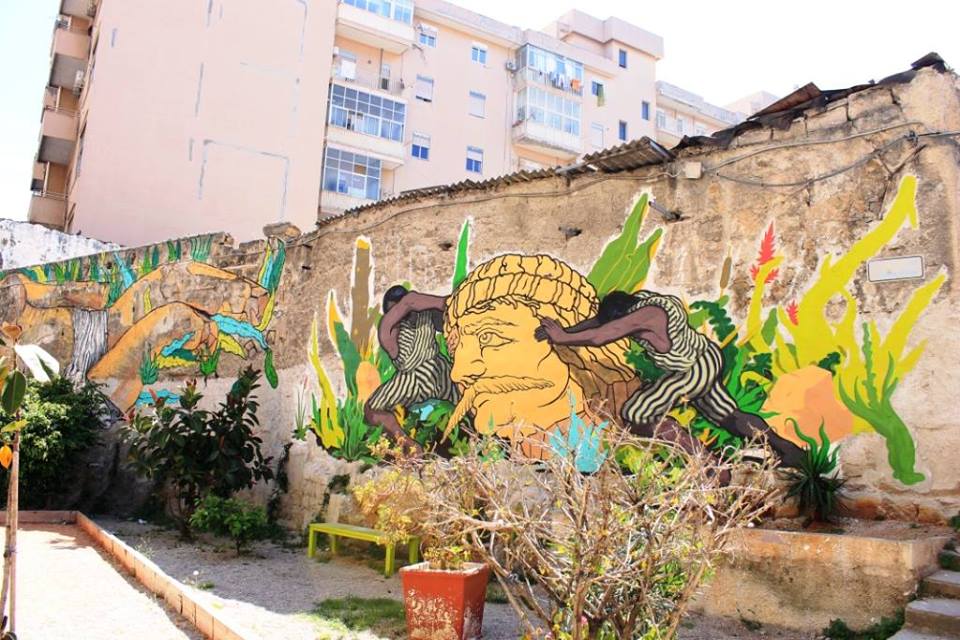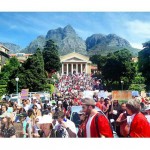The anti-mafia movement: A fight with many faces
As I enjoy an espresso and a cigarillo in a tiny coffee bar in the old quarters of Palermo I look out over the streets where the number of vespas and tourists are countless. Somehow the modern aspects of Sicily´s capital seem distant and out of place in a context where the historical and cultural heritage has much more of an impact on me. Narrow alleys with lines of swaying laundry hanging across the streets gives a genuine atmosphere of historical presence.
The Cosa Nostra is as old as many of the buildings surrounding me and has endured in Sicily since the middle of the 19th century. Together with four students from Gothenburg and approximately thirty young representatives from other EU countries, I am here for the Erasmus+ programme Hand in Hand Against Mafia with the aim of promoting democratic values and combating organized crime within European society. It is a fact that organized crime is a common concern for several European nations and therefore initiatives like these are of high value. Libera Palermo, the organization behind this project, is a local entity of the national organization Libera, which is working on several fronts to combat organized crime. Promoting the raising of minimum salaries and organizing events for companies and other actors to come together and share experiences on how one might handle extortion and other forms of harassment, are only a few examples of Libera´s work. Structural changes in society may be of vital importance since it might prevent the incentive for low-income earners to consider organized crime movements as a way of securing their rightful “piece of the pie”. This is especially crucial in the case of the younger generation, which is mainly the target for recruitment by the Mafia.

Teatro Massimo, where the final scenes from the Godfather Part III took place is located a few blocks away from where I am sitting. On one level the Cosa Nostra seems absent whereas the effect of the Mafia´s presence is an intrinsic part of Palermo and Sicilian society. Just across the street from where I am sitting the building is beautifully decorated with graffiti. As in other parts of the world graffiti serves as a form in which to challenge power, and in Sicily the main power to challenge is the Cosa Nostra. This graffiti painting fully serves this purpose, illustrating an octopus with its tentacles spreading in all directions, a symbol of the Cosa Nostra and its damaging effect on Sicilian society. Talking with local Sicilians, some will give you a hint of what the Mafia is capable of. Extortion, in the form of having to pay protection money, is common for most business owners. The extortion money paid to the Mafia is labelled pizzo and if a business owner does not pay it a friend might visit arguing the benefit of paying the pizzo, in the business owner´s best interests. If the money is still not paid a smashed window or glue in the keyhole might be the next step taken by the Cosa Nostra. Direct interaction with the victims is preferable to avoid exposure.
The image of the Mafia during the last decades has in many cases served as fictional romance. Generations have been brought up with an image of the Mafia, portrayed through fictive characters such as Michael Corleone and Tony Soprano. The gap between fiction and reality is significant. Our extravagant anti-heroes do engage in illegal activities, such as smuggling, extortion and murder, but what separates them from real Mafiosi is that they convey the aura of romance. Real Mafiosi such as Salvatore “Totto” Riina, John Gotti and Bernardo Provenzano do not uphold the same ambiance as their counterparts on our TV screens. Riina, often described as one of the most ruthless Mafioso of all time, was responsible for the death of 100-200 people, including the two anti-mafia magistrates Giovanni Falcone and Paulo Borsellino.
Except for the Cosa Nostra in Siciliy, the main Italian Mafia organizations consists of the Ndrangheta in Calibria, the Sacra Corona Unita in Apulia and the Camorra around the city of Naples. While many believe that the Mafia is here to stay with its tentacles deep in Italian institutions and political life Carina Gunnarsson from Uppsala University, an expert in the field of anti-mafia work, argues that the anti-mafia movement is a major force to be taken into consideration, even if their efforts seem to get little attention in media. Since the 1980s a strong movement among the civic society has stood up towards the Mafia. While there have been civic forces fighting the Mafia since the 1860s, the movement has moved from the countryside and is now mainly driven by an urban educated middle class. The grassroots movement Addiopizzo is an archetype portraying the fight. During the last decade it has achieved a clear impact. By working together with business owners, who do not want to pay the pizzo, they hit the Cosa Nostra on an economic level and prove that standing up towards organized crime is possible. The fact that the initiative was taken by five young activists in 2004 illustrates that actions made by just a few people can have a major impact. The organization´s motto is “A whole people who pays the pizzo is a people without dignity”. While the initiative is brave as well as bold, it is highly dependent on socially conscious motivated consumers.

Since the 1990s the Cosa Nostra has followed a strategy where the organization´s aim is to keep a low profile. Some might argue that the public outcry after 1992, when the two anti-mafia magistrates Giovanni Falcone and Paolo Borsellino were brutally murdered by the Cosa Nostra, has forced the Mafia into this strategy. Others would argue that peace only certifies the effectiveness of the Mafia where the use of violence is an indication of weakness. What is obvious is that more than 20 years later the situation with the Cosa Nostra has changed radically.
Initiatives to counteract organized crime have been taken by the Italian government for decades, but for a long time the Christian Democrats in Rome had links with the same forces that they argued they wanted to get rid of. To what degree the Mafia still has connections amongst politicians, law enforcement agencies and other institutions is difficult to comment upon, but it is clear that civic society may have a significant role to play because government strategies have not been sufficient. While the Mafia is still a taboo topic among many Sicilians others have decided to take action. Allessandro is one of them. After one of his family members was shot dead in the streets of Palermo he has been dedicated to fight organized crime. Civilian bystanders with no connection to the Mafia might become victims just because they are in the way. A common technique for Mafia members is namely to move among civilians, serving as shields against the police or other Mafia sections competing for economic influence or power. Allessandro is not alone in his struggle. The anti-mafia organization Agenda Rossa has the aim of protecting people who are at risk of being victimised by the Mafia. By organizing large manifestations functioning as a ”bulletproof vest”, Agenda Rossa therefore prevents assassinations carried out by the Mafia, using the same method as the Mafia.
What is evident is the fact that presently civic society constrains the position of the Mafia to a certain degree, not only by a few strong front figures such as Falcone and Borsellino, but by a large number of ordinary citizens who have decided that they are no longer willing to be compromised in their daily lives. The struggle takes many forms and minor efforts might just constitute “a drop in the ocean”, but as long as they are somehow connected they represent a major force. What is even more important to remember is the fact that organized crime is not just limited to southern Italy but also an increasing issue in several other European countries. Therefore governments and civic society all around Europe should sense the importance of acting against organized crime.
The European Commission support for the production of this publication does not constitute an endorsement of the contents which reflects the views only of the authors, and the Commission cannot be held responsible for any use which may be made of the information contained therein.


